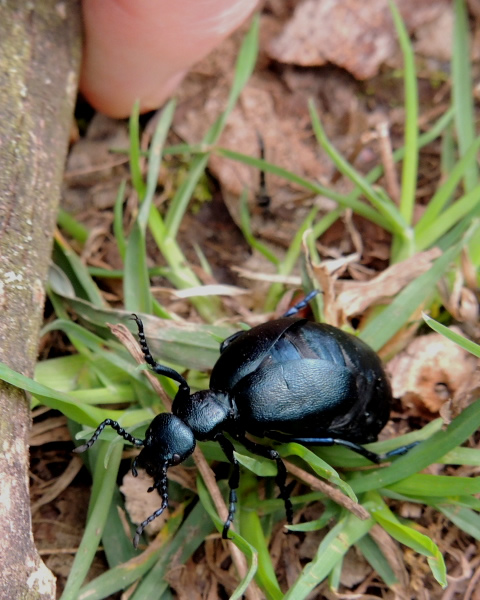Blagdon Lake Birds
April 2013 News
Monday 1st April [A biting east wind and cloudy]
It was perishingly cold on the dam this morning and only Ian White stuck it out in the hope of getting some Osprey Pandion haliaetus pictures. He did manage a few shots of a bird which flew over a couple of times, that I hope to be able to identify later, but there wasn't much action. I saw an Osprey perched in the back of Holt Copse at lunchtime that I kept quiet about so that it didn't get disturbed. It was looking tired and kept closing its eyes. Unfortunately, it had its back to me so I couldn't identify it. The Common Sandpiper Actitis hypoleucos was on the dam wall and there were 6 Sand Martins Riparia riparia on the wing at Top End when I went for a look around. I shall be down there most of the afternoon hoping we don't get any more mishaps with birds under nets. There is a cracking picture of ♂ white 'YA' taken yesterday, during the rescue, by Rob Owen from Kent.
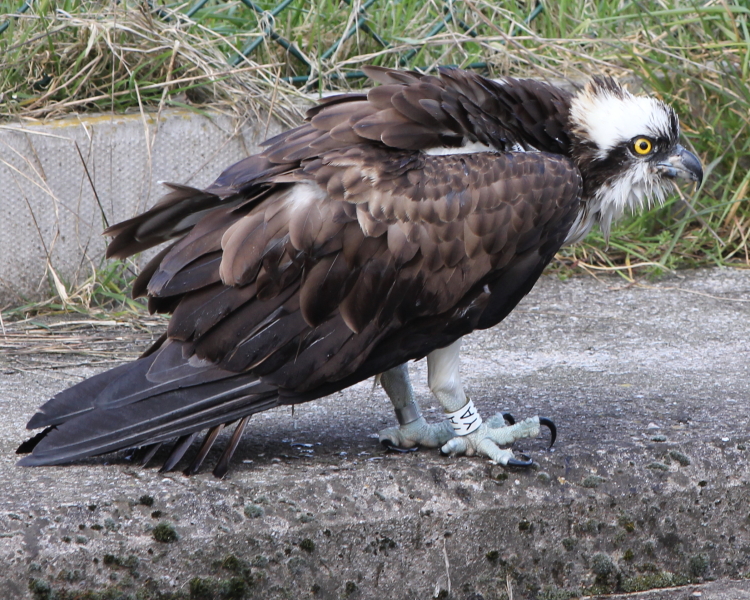
The afternoon shift livened up at 1610 hrs when a new Osprey turned up at the Pumping Station with a green ring on the left leg and BTO ring on the right leg (Scottish origin). I have some pictures which may allow us to sort out the symbols - has anyone else got any? I tried very hard to read them through the scope in the windy conditions but failed dismally. At 1635 hrs we saw another bird over Holt Bay which the green-ringed bird flew towards. At 1645 hrs one bird flew back towards us carrying a large fish, flew away over the dam and was lost to view. Then, at 1710 hrs white 'YA' flew in to the Pumping Station grounds.... you can guess the rest. We released him from the nets again at around 1800 hrs, within a few minutes, but he didn't get the bonus of a free meal today. Blagdon ringer Warwick White came to the rescue.
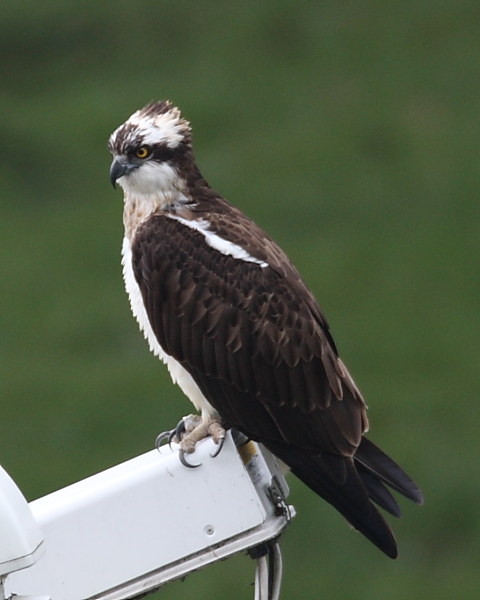
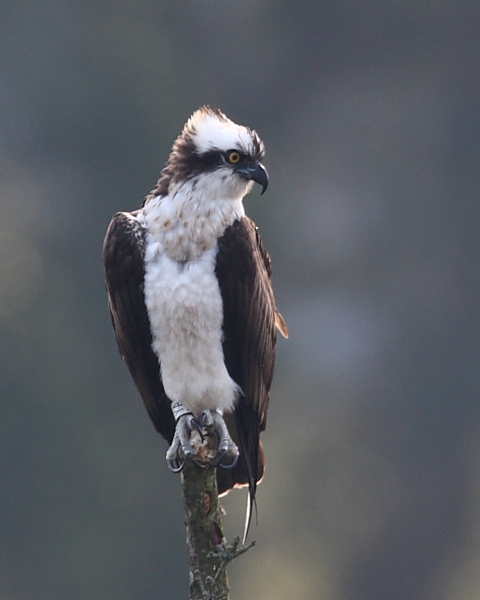
Ian White sent me some pictures of the bird he saw this morning which clearly show a green ring and was likely to be the bird I photographed this afternoon. So, we had white 'YA' and a new bird that I'll update you about if the Scottish ringers can identify it.
Tuesday 2nd April [Sunny and windy]
Melanie Patch has kindly emailed to tell me that the green-ringed bird was back at the Pumping Station this morning at 0720 hrs and flew off along the south shore of the lake hunting at 0750 hrs. I did a stint from 1000-1245 hrs during which I saw 2 Ospreys Pandion haliaetus at 1030 hrs, one of which flew off west. The other bird appeared to be hanging around; it was hunting at 1100 hrs, and at 1200 hrs did a circuit of the lake, flew over the Pumping Station and landed on The Island for about 10 minutes, before flying back towards Top End at 1230 hrs. I wasn't able to identify any birds this morning. However, I'm pleased to report that the fisheries team are working on the nets over the channel behind the dam, where white 'YA' has been trapped 3 times, with a view to blocking the holes that birds are getting through.
The interest in the Ospreys has been pretty phenomenal and there has been a great opportunity for positive PR. I'd estimate that at least 300 birders have visited, and lots of members of the public have stopped and had the chance to see their first Ospreys up close and personal through the telescopes we set up, especially local villagers.
Common Buzzards Buteo buteo and a couple of Eurasian Sparrowhawks Accipiter nisus were soaring in the sunshine this morning, but I haven't spotted any obvious migrant raptors yet. We also had the small party of Sand Martins Riparia riparia hunting around the Top End trees.
When I got back to the lake this afternoon, I'd missed one fly-over by an unidentified bird heading east at about 1400 hrs. Then we had a long wait until Simon Isgar spotted a bird at 1815 hrs back at the dam. It turned out to be ♂ white 'YA' who then hung around the Pumping Station until 2005 hrs before disappearing behind the building. He didn't do anything stupid this evening, thankfully. While we were keeping an eye on him another Osprey sneaked into the trees at Spinney Point. It sat there until 1945 hrs before doing a bit of fishing along the south shore then it flew back to the dam and headed off in the same direction that the green-ringed bird had with a fish yesterday, so I'm assuming it was that bird again. While the small gathering were watching events unfold with the Ospreys, someone spotted the summer-plumaged Black-necked Grebe Podiceps nigricollis swimming in front of the Lodge that Gary Thoburn had been watching and photographing a bit earlier at Wood Bay. So, sorry Joanna Dailey, white 'YA' is hanging on here for the moment it seems! Indeed, Gareth Jones emailed to say he was at Chew Valley Lake at 1300 hrs this afternoon, which would explain why we haven't been seeing him at Blagdon during the day. Looking at Rich Andrews Twitter feed Lauren Tucker has posted a picture of an Osprey that caught a trout at Chew around 1600 hrs (I think) that I can't see rings on (can anyone else?) and that I don't recognise. I'm wondering now if this was the bird that flew high to the east over Blagdon Lake at around 1400 hrs. Lauren said it flew off east from Herriott's Pool when it caught the Brown Trout. Can any of the Chew observers help with an identity?
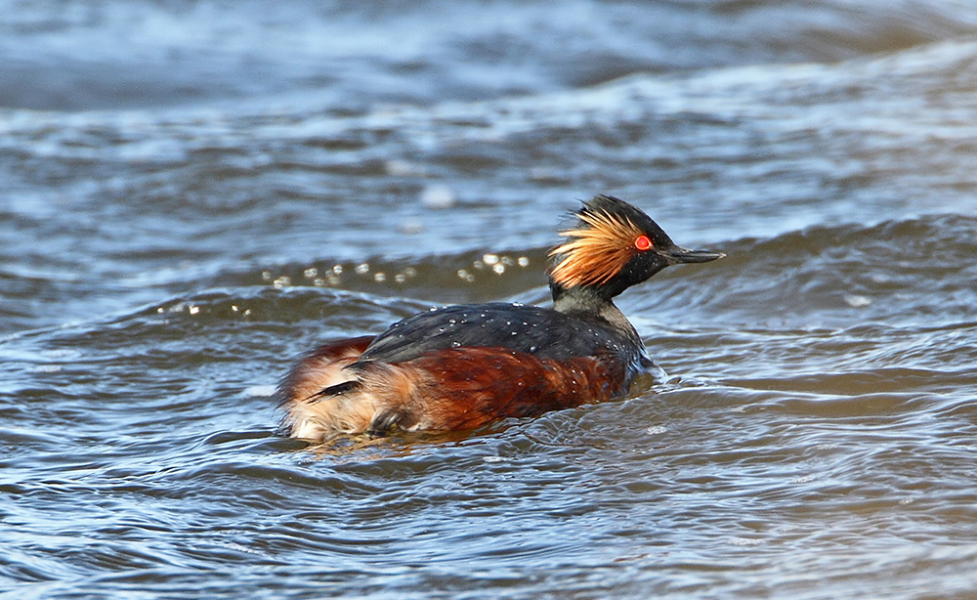 Black-necked Grebe, Wood Bay © Gary Thoburn 2013.
Black-necked Grebe, Wood Bay © Gary Thoburn 2013.
This evening we saw a couple of Badgers Meles meles on the back doorstep. I'd suspected they were coming into the garden again for spilt sunflower hearts from the bird feeders, so I put some peanuts down and we watched them under the patio lights. Magic!
Wednesday 3rd April [Sunny and very windy]
Osprey Pandion haliaetus white 'YA' was at the Pumping Station early morning before flying east towards Top End (perhaps to Chew where a bird was reported on Herriotts at 0930 hrs by Simon Isgar) and another bird flew around the lake at around 0900 hrs. John Harris of the fisheries team saw an Otter Lutra lutra in front of the Lodge early morning and there was a Little Ringed Plover Charadrius dubius also at the Lodge until 0915 hrs at least. There were at least 50 Meadow Pipits Anthus pratensis around the Burmah Road / Bell's Bush meadows yesterday and today.
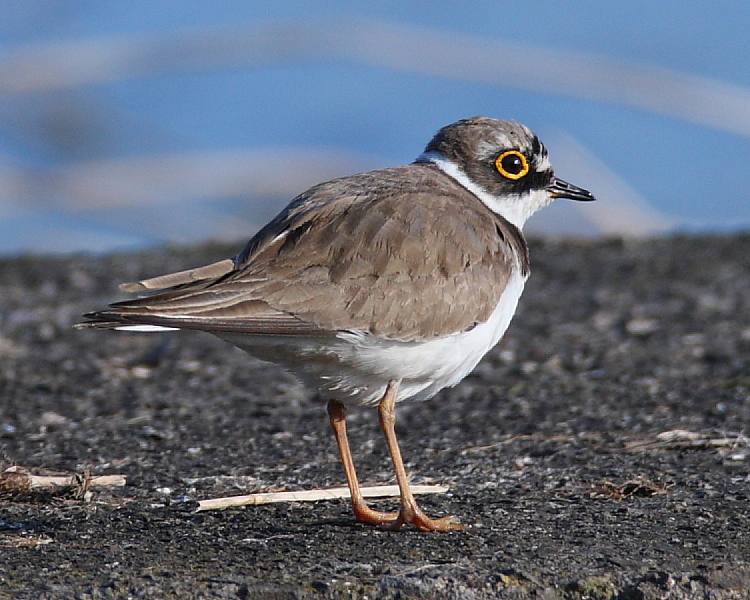
I went for a circular walk with friends this morning from King's Wood to Crook Peak and back. We saw 4 or 5 Ring Ouzels Turdus torquatus and lots of Northern Wheatears Oenanthe oenanthe on the hills and the first Wood Anemones Anemone nemorosa of the spring in King's Wood.
This afternoon I saw an unidentified Osprey (possibly white 'YA' with a missing tail feather) circle around the lake between 1550-1605 hrs and head back to Top End where I later saw 2 Barn Swallows Hirundo rustica and at least 2 Sand Martins Riparia riparia hawking insects around the Top End trees. A Sandwich Tern Sterna sandvicensis flew through to the west at 1615 hrs and, surprisingly, the Common Sandpiper Actitis hypoleucos was on the dam. I did not see any Ospreys back at the lake this evening between 1900-2005 hrs.
You can find out more about the Osprey white 'YA' at http://kielderospreys.wordpress.com/ and, hopefully, read about his arrival back at Kielder Water in due course.
Thursday 4th April [Windy, overcast and cold]
Now that the 'Osprey Fest' appears to be over, I thought I'd better get on and carry out my usual spring migrant survey around the lake. I generally do two a year, at the beginning of April and May. However, the weather has been awful to say the least and this morning was no different, so I've decided to do a day list. I have yet to hear a Chiffchaff Phylloscopus collybita sing, but I saw 28 around the lake today, mostly in groups in sheltered spots right by the water's edge, where they are desperately trying to find enough insects to keep themselves alive. The only other migrants of note (no Blackcaps) were about 40 Sand Martins Riparia riparia and 4 Barn Swallows Hirundo rustica feeding at Top End, and about 150 Meadow Pipits Anthus pratensis along the South Shore. The summer-plumaged Black-necked Grebe Podiceps nigricollis was also at Top End, feeding on insects off the water and viewable distantly from the hide. The Common Sandpiper Actitis hypoleucos was on the dam. Despite the lack of migrants (and Ospreys), I totted up 63 species in 4 hours. This afternoon I only managed to add Stock Dove Columba oenas; 2 at Lodge Copse.
Some of you may have noticed work being carried out on the 'Venturi Building' at Pipe Bay in the last few days. This is to make the building structurally safe and renovate the outside with a view to transforming it into a 'Bat House'. I will write up more about the project in due course and post dates of some of the trapping sessions that we will be carrying out in the Bat Info: News section. We intend to analyse the mass of data that we captured last year, on the passive monitoring equipment, in the next few weeks and Daniel is hoping that we will be able to carry out some more radio-tracking of the Nathusius' Pipistrelles Pipistrellus nathusii this spring.
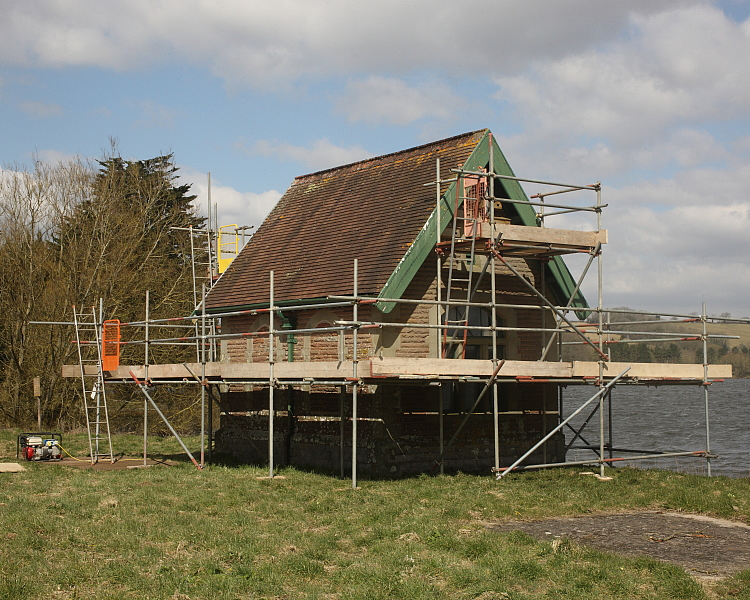
Gary Thoburn has just sent me a couple of pictures of the Black-necked Grebe taken a couple of days ago in the sunshine when he came over to Blagdon after work. I've put one into the text on the 2nd April - nice one Gary!
Friday 5th April [Sunny and windy, but less cold]
I didn't visit the lake this morning, but after a meeting with Bristol Water about the new 'Bat House', I had a chat with Andy and Tom of the fisheries team and Andy said he'd seen an Osprey Pandion haliaetus hovering at Top End at about 0745 hrs. I spent the afternoon by the lake, and at Top End I saw the usual flock of Sand Martins Riparia riparia with a couple of Barn Swallows Hirundo rustica and my first House Martin Delichon urbicum of 2013. I also heard a Water Rail Rallus aquaticus squealing near the hide. This brings the site list to 100 species for the year so far. On my walk back from the entrance gate I spotted what I felt sure was an Osprey over the dam end at about 1650 hrs 'spooking' all the gulls. I mentioned it to a birder I met near Home Bay and had a look around from the dam. About 10 minutes later I spotted an Osprey hunting in the lee of the Indian Country pine belt, so I drove back along to Top End to see if it had perched up, but I couldn't find it again. The other birder had seen it at Home Bay Point just after I'd mentioned it to him. Perhaps it's commuting between BL and Chew.
Eurasian Wigeon Anas penelope numbers look like they've dropped to 7 overnight and I heard my first Chiffchaff Phylloscopus collybita song at Pipe Bay today. Hopefully, the weather forecasters predictions for tomorrow will be right, and the spring sunshine will bring sufficient warmth for some birdsong as I carry out my April survey early in the morning.
I received an email yesterday from Joanna Dailey at the Kielder Osprey Project to tell me white 'YA's older brother Yellow '37' has been positively identified today visiting Nest 1. He was there a couple of days ago but they couldn't read his ring because of camera problems; he was arranging twigs on his own nest yesterday. And today (4th) the resident female was back on Nest 1 they believe. She arrived in the middle of the day and set about the usual 'nestoration' of shuffling twigs, preening and squawking! She was there on and off during the afternoon, so they hope the respective other halves come back soon or she and Y37 may find a mutual attraction! There are nest cams at Kielder that Joanna puts information about, with still pictures, on her blog at http://kielderospreys.wordpress.com/. Although there may have been 2 Ospreys (per Don Smith) still at Chew yesterday, we know that one of them was not ringed, so unless the other was white 'YA', perhaps he's now on his way to Northumberland and will be 'starring' on the cameras soon. Let's hope so.
Saturday 6th April [Sunny and warmer]
It was cold last night and there was ice in the bays and around the Spillway / Butcombe Bank first thing. I carried out my survey of passerines around the lake (using Breeding Bird Survey methodology) between 0730 and 1115 hrs. The pick of the count were 36 Winter Wrens Troglodytes troglodytes, 33 Chiffchaffs Phylloscopus collybita, 8 Great Spotted Woodpeckers Dendrocopos major and 4 Eurasian Nuthatches Sitta europaea. I also recorded the Common Sandpiper Actitis hypoleucos, a Eurasian Woodcock Scolopax rusticola, my first spring Blackcap Sylvia atricapilla (but only one), Fieldfare Turdus pilaris, Redwing Turdus iliacus, 30 Eurasian Wigeon Anas penelope, 4 Barn Swallows Hirundo rustica and at least 25 Sand Martins Riparia riparia. Mervyn Pearce saw a Little Egret Egretta garzetta this afternoon at Indian Country. Much of the woodland was silent and although I heard a few Chiffchaffs singing, most of them were in small groups beside the water in sheltered spots feeding. Two new Nuthatch territories and the Woodcock were the highlights of the morning though.
This afternoon I went for a look around Draycott Sleights and Housegrounds across the road. I had great views of 3 ♂♂ and 1 ♀ Ring Ouzels Turdus torquatus, although there were undoubtedly more there, with Simon Mackie suggesting perhaps as many as 20.
Sunday 7th April [Overcast with sunny spells and a cold SSE wind]
Good news, migration and sad news!
Osprey Pandion haliaetus white 'YA' has touched down at Kielder this afternoon at his nest site! Joanna Dailey emailed: "White YA landed at 2.18pm! He had a wander round his nest, a bit of a shake, said hello to the female who has been around a couple of days and then went off. Looking for nets no doubt!" See Joanna's blog at http://kielderospreys.wordpress.com/. What fantastic news.
This afternoon Daniel Hargreaves and I were surveying an area at Blagdon Lake at the request of BW and Daniel found some Cave Spiders Meta sp. in a culvert he was examining for bat activity. The two UK species Meta menardi and M. bourneti are not easy to distinguish from one another, unless examined under high magnification. We also saw an egg sac suspended from the roof, like a BIG white tear drop on a thread. The adults shy away from light, but the spiderlings are attracted to light, which is thought to be an evolutionary adaptation to facilitate colonisation of new habitats. There was also a moth called the HeraldScoliopteryx libatrix hibernating in one of the culverts.
I visited the lake late morning and on the way down the hill saw an amazing kettle of Common Buzzards Buteo buteo over the village. I jumped out of the car and counted 16 before a car coming up the hill forced me to move. Warwick White working in his garden rang me and said he was watching 17 Buzzards overhead too, so I drove along to Rainbow Point to get a better, and wider, viewpoint. During the period between 1130-1200 hrs at least 30 Buzzards climbed high over the village and went into long easterly glides along the lake, clearly on migration. Of course, local birds were attracted to rise up from their territories (there are 5 around the lake) in response to the passing birds so there were Buzzards all over the sky. I wonder how many I'd missed beforehand, while I was watching the British Junior Cycle Road Race pass up the hill by the house?
The Common Sandpiper Actitis hypoleucos was on the dam and summer-plumaged Black-necked Grebe Podiceps nigricollis back in its usual corner at Burmah Road. There were no hirundines at Top End, so I guess they've moved on with their migration too.
I forgot to mention the bat that Des Brommage and Bill Blake found on the back of the dam during the evening of 2nd April while Osprey watching. I was called over as it disappeared into a crack and from the limited view I had of it, thought it was probably a Daubenton's Bat Myotis daubentonii. After Daniel and I met with BW on Friday we went for a look to see if it was still there. It was in the same place but had died. Daniel fished it out of the crack and we were able to see that it was an emaciated ♂ Daubenton's Bat, presumably caught out by the cold weather.
Daubenton's Bat Myotis daubentonii roosting on the dam wall © Des Brommage, 2013
I ran my 15W Heath Trap overnight (min. temp. 2 Celsius) at Lodge Copse and caught:
B&F2187 Common Quaker Orthosia cerasi 1
Monday 8th April [Watery sunshine]
Simon 'Earlybird' Isgar, John Harris and angler Mike McChurn saw an Osprey Pandion haliaetus this morning over dam end at 0850 hrs that flew towards Top End. We couldn't relocate it by 1130 hrs when we went to Litton Reservoirs to see what was going on there (we saw a Little Egret Egretta garzetta). Chris Stone reported an Osprey later, at Chew Valley Lake, that caught a fish and flew towards Moreton. It was pretty quiet at Blagdon today, with just 5 Barn Swallows Hirundo rustica and 3 Sand Martins Riparia riparia at Top End, and the Common Sandpiper Actitis hypoleucos on the dam.
Daniel and I have agreed some bat survey dates in the coming weeks that we'd like to invite interested local people to come along to, if you think you might be interested in helping monitor the lakeside boxes and join in with the Nathusius's Pipistrelle Project. There will be little activity during the high summer months while the bats breed, then we'll have some more trapping sessions in the autumn, including a joint meeting with Bristol & District Moth Group on the 9th August (National Moth Night). I ran my moth trap at the lake last night and caught one moth (see 7th April). I wonder what the coming season will bring after last summer's deluge, I suspect moth numbers will be well down.
Tuesday 9th April [Grey, overcast and cold in the wind]
When is spring going to arrive? I had a short walk at Top End late this morning and saw about 25 hirundines, the majority of which appeared to be Barn Swallows Hirundo rustica, with a few Sand Martins Riparia riparia mixed in. A couple of Water Rails Rallus aquaticus squealed at each other and 9 Common Snipe Gallinago gallinago flew out of a flooded roadside meadow. On the other side of the road, there was a tremendous chattering of Fieldfares Turdus pilaris and Redwings Turdus iliacus going on in the top of some Oaks. I guess they're trying decide when, or if, they're going to leave for Scandinavia!
As the sun went down the wind dropped and the lake became like a mirror. The summer-plumaged Black-necked Grebe Podiceps nigricollis was feeding about 150 metres out from the bank in Wood Bay and when I looked at it through the scope it was sitting in a carpet of little midges on the water that it was feeding avidly on. I looked around and the whole surface of the lake was covered in millions of hatching midges. I counted 26 Northern Shovelers Anas clypeata (mainly at Rugmoor) scooping up the midges too. There were about 60 Meadow Pipits Anthus pratensis feeding in a meadow in the lee of Holt Copse. A couple of the pipits were noticeably brighter with a marked whitish supercilium, tertial feather edging and wing bars. I couldn't see the legs in the long grass and had it been winter I would have suspected Water Pipits, but at this time of year they would surely have been attaining summer plumage. Could they have been the Icelandic race of Meadow Pipit referred to by Keith Vinicombe in his MacMillan Field Guide to Bird Identification or even Tree Pipits? I might look for them again tomorrow evening when I get back from my walk and hope to get a better view. At Top End a Little Egret Egretta garzetta flew west overhead and as I made my way back a ♂ Tawny Owl Strix aluco sang out from a lakeside copse, it's call carrying far across the water to be returned by another on the far bank. I found a little pile of feathers, perhaps the victim of a Eurasian Sparrowhawk Accipiter nisus. I retained some in my notebook, because I thought they might be from a Common Snipe Gallinago gallinago, or similar, and probably worth checking out. What a lovely mild evening it turned out to be when the wind died down, I even saw a Common Toad Bufo bufo crossing Park Lane towards the lake on the way home.
I'm going to Cardiff Museum this weekend for a two day Hoverfly course, but I haven't even seen one this year, so far. I examined some 'Pussy Willow', Sallow, this morning and there wasn't an insect to be seen on it at all. I also looked up my records of Hawthorn Crataegus monogyna coming into leaf because some started to show at the Ubley entrance 2 days ago. I have seen leaves as early as 16th February in the past, though usually expect it to show during the first week of March ordinarily, so we are at least a month late this year.
Wednesday 10th April [A milder day with weak sunshine]
I didn't visit the lake today (I walked 15.5 miles from May Hill to Gloucester Docks). However, Simon Isgar sent me a text to say he'd seen a ♂ Brambling Fringilla montifringilla under the feeders at the Lodge, and suggested there may actually have been more than one present. This is the first record for 10 years.
Yesterday evening, there were quite a few small bat sp. flying along the south shore at dusk. A few Willow Warblers Phylloscopus trochilus have turned up locally today, so I hope to find some by the lake tomorrow.
Thursday 11th April [Mild with sunshine and showers]
No sign of the Brambling at the feeders today, but I was very pleased to see Reed Buntings Emberiza schoeniclus visiting. There were several Willow Warblers Phylloscopus trochilus singing and I heard a couple of Blackcaps Sylvia atricapilla too. At Top End, I saw about 25 each of Barn Swallow Hirundo rustica and Sand Martin Riparia riparia around the trees, that occasionally perched on roadside wires to preen. Later in the evening, after a large storm went over producing a lovely rainbow, a new and larger flock of hirundines dropped over the lake, but I didn't find any other new birds. I did, however, note two groups of 4 Little Grebes Tachybaptus ruficollis in Long Bay and at Top End sitting on the water together, which was rather curious. I wonder what they were doing? They didn't appear to be antagonistic towards each other.
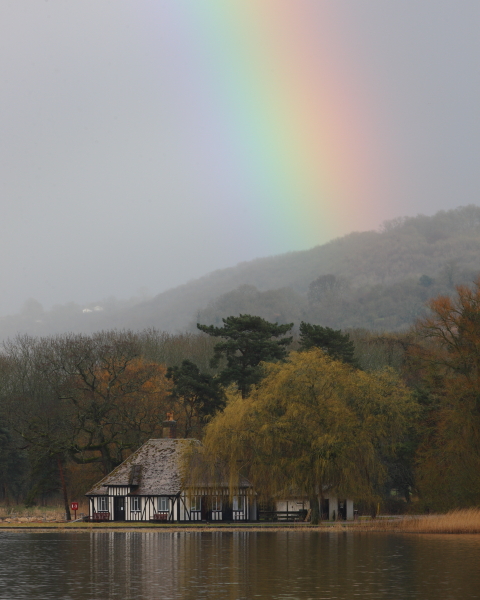
As far as winter visitors are concerned, I didn't see any Fieldfares or Redwings today, but there were at least 3 Common Goldeneyes Bucephala clangula (a 1st-year ♂ and 2♀♀) and 10 Eurasian Wigeon Anas penelope hanging on.
Friday 12th April [Mild with sunshine and showers]
I surveyed the lake this morning, even though the weather wasn't great, and noted 23 Chiffchaffs Phylloscopus collybita, 21 Willow Warblers Phylloscopus trochilus (most of which were singing) and only 3 Blackcaps Sylvia atricapilla. There were 3 Common Sandpipers Actitis hypoleucos and probably 500 or more hirundines, with at least 20 House Martins Delichon urbicum among them. I also saw 12 Meadow Pipits Anthus pratensis at Long Bay. Of the 'hangers-on' there were at least 22 Eurasian Teal Anas crecca in the Spillway, 12 Eurasian Wigeon Anas penelope at the dam and 4 Common Goldeneyes Bucephala clangula (adult and 1st-winter ♂♂ and 2 ♀♀). The 2 Lesser Redpolls Carduelis cabaret that have been noted several times at Hellfire Corner were still there today.
It was lovely to see some Cowslips Primula veris coming into flower, especially on the North Shore.
Saturday 13th April [Miserable, grey and wet]
I had a quick look around this evening, after a day of peering down a microscope in Cardiff Museum at Platycheirus hoverflies. I saw just a few hirundines, a couple of Common Sandpipers Actitis hypoleucos on the dam, the same 4 Common Goldeneyes Bucephala clangula noted yesterday, a pair of Eurasian Wigeon Anas penelope at the dam and a flock of 100-200 Fieldfares Turdus pilaris and Redwings Turdus iliacus at Top End. However, Sean Davies spotted the elusive summer-plumaged Black-necked Grebe Podiceps nigricollis at Burmah Road, that I've looked for on a daily basis.
Sunday 14th April [Dry]
There were 3 Common Sandpipers Actitis hypoleucos and 4 Eurasian Wigeon Anas penelope on the dam first thing this morning and a pair of Common Shelducks Tadorna tadorna flew through towards Chew. There didn't appear to be a gull roost last night, but about 5 each of Black-headed Chroicocephalus ridibundus and Common Gulls Larus canus (mainly 1st-summers) dropped in to bathe with a handful of Lesser Black-backed Gulls Larus fuscus before I left at 0745 hrs. There were a few Willow Warblers Phylloscopus trochilus and Chiffchaffs Phylloscopus collybita singing along the south shore.
Apologies for the late notification, but Sean Davies texted me this morning to say he'd spotted the summer-plumaged Black-necked Grebe Podiceps nigricollis at Top End Hide. I've been in Cardiff Museum again today, learning how to identify Cheilosia hoverflies!
Daniel Hargreaves checked some of the bat boxes and found 3 Soprano Pipistrelles Pipistrellus pygmaeus roosting in separate boxes, as well as 3 Daubenton's Myotis daubentonii roosting together (one of which was ringed) in a drainage slot.
Monday 15th April [Cloudy with some sunny spells]
Terry Doman and I carried out the WeBS Count this morning and were pleased to see at least 2 Common Swifts Apus apus among the hirundines over the lake during the survey (my 100th species at BL for the year). There has also been an arrival of Blackcaps Sylvia atricapilla, which were everywhere there was a bit of cover, many of them singing. The duck count was pretty unremarkable, as we've come to expect at this time of year, the main surprise being the low count, 33, of Mallards Anas platyrhynchos. Tufted Duck Aythya fuligula numbers were still quite bouyant at 189, but Common Coots Fulica atra totalled just 138. No sign of the Black-necked Grebe today, but I did see 2 Otters Lutra lutra swimming one behind the other along the south shore this evening. I'm guessing they were probably mother and cub, rather than a pair of adults.
I saw 2 Peacocks Inachis io and a Small Tortoiseshell Aglais urticae as well as a few Eristalis sp. hoverflies on the wing at Top End during a brief sunny spell at lunchtime.
Tuesday 16th April [Sunny and windy]
There were two new migrant species in today; a couple of Reed Warblers Acrocephalus scirpaceus singing from Pipe Bay reeds and 2 Common Terns Sterna hirundo first thing, which rose to 11 during the day, and 13 by 1630 hrs. There were 2 Common Swifts Apus apus among the hirundines over dam end again this morning and I saw 3 Common Sandpipers Actitis hypoleucos on the dam wall this evening. I recorded a total of 56 bird species at the lake today including Eurasian Siskins Carduelis spinus on the feeders, a pair of Mistle Thrushes Turdus viscivorus on the dam and a pair of Common Shelducks Tadorna tadorna at Green Lawn.
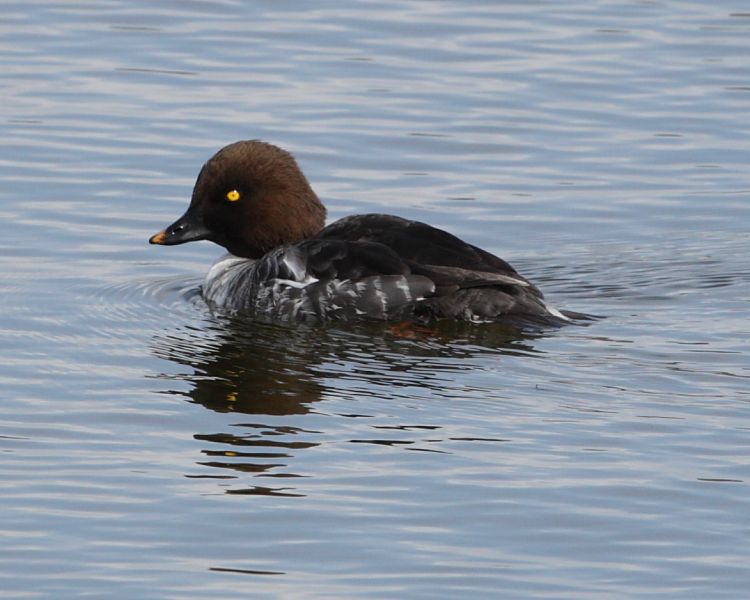
I started my two year survey of the Hoverfly Syrphidae fauna of the lake today and caught:
- Eristalis pertinax 2♀♀ on Lesser Celandine Ranunculus ficaria at Flower Corner
- Eristalis intricarius 1♂ on Sallow Salix sp. catkins at Bell's Bush
- Eristalis pertinax 1♂ on Sallow Salix sp. catkins at Bell's Bush
The more common Drone Flies at the lake appear to be E. pertinax rather than E. tenax in my experience. I also saw a ♂ Violet Oil Beetle Meloe violaceus at Flower Corner.
While I was surveying, I came across a 'ball' of 4 Common Toads Bufo bufo, a single ♀ with 3 ♂♂ on her back in amplexus. I carried them to safety by the water's edge. On the way home last night I must have moved at least 30 off the road!
Wednesday 17th April [Southerly gale]
The fishing boats were cancelled at Chew today, due to the windy conditions, so a few boat anglers transferred to Blagdon, given that it is more sheltered by the Mendips when the wind is from the south. Undeterred, I birded the north shore but couldn't hear any birdsong due to the wind. It was wild over there! There were hirundines in large numbers (too many to count) over the lake all day, including at least 3 Common Swifts Apus apus. I saw 2 Common Sandpipers Actitis hypoleucos (one on the dam and one at Peg's Point, of all places) and there were 3 Common Terns Sterna hirundo present from mid-morning. It's curious that all the inland terns are being reported as Arctics in Somerset (Cheddar and Noah's) whereas the Chew and Blagdon birds are Commons. Mind you, I decided to photograph some of the Blagdon birds yesterday, just to convince myself! A single ♀ Common Goldeneye Bucephala clangula is loitering around the dam, but there was no sign of any Eurasian Wigeon Anas penelope or Gadwall Anas strepera, so the species count was down to just 53 today. I've seen Common Coots Fulica atra sitting on nests already, but the one pair of Mute Swans Cygnus olor that over-wintered are showing no interest yet. I suspect the swans have been put off by the lack of weed growth. The lake was 96% full on 11th April, having dropped about a foot off top level, so conditions are good for other waterfowl to nest.
This evening I sat in Top End hide until dark and rather excitingly a Eurasian Hobby Falco subbuteo made about a dozen passes along the edge of the wood within a few feet. I saw it make an attempt at one of the bats that were also feeding along the edge of the wood.
Thursday 18th April [Westerly gale and sunny]
This morning there were 20-25 terns at the lake at least some of which were Common Terns Sterna hirundo (unfortunately I had no scope available), but by late afternoon with my scope to hand, the total had risen to 43, the majority of which appeared to be Arctic Terns Sterna paradisaea. I think there was some turnover (ho, ho) during the day, so to be able to give totals of both species is impossible. I think it best to record 43+ 'comic terns' under the circumstances. The single ♀ Common Goldeneye Bucephala clangula and 3 Common Sandpipers Actitis hypoleucos were still present at the dam.
It was really wild, with the westerly gale howling down the lake driving white horses before it, putting some of the early Common Coot Fulica atra nests at risk of inundation. There were fewer terns, just 20 or so, this evening at 2000 hrs.
I'm sorry it has taken a while to update the tables with this years April Migrant Walk data, but here it is, and doesn't it illustrate the late arrival of Willow Warblers and Blackaps nicely, in comparison with other years? On the 12th April there were still only 3 Blackcaps around the lake, though the Willow Warblers were well in evidence by then. But, by the 15th April Blackcaps had flooded in and there was hardly a bush without one in it!
It appears that the cold weather hasn't caused too much of a problem for the local Winter Wrens, with the number of singing ♂♂ remaining comparable to previous years. The morning of the survey, 6th April, didn't provide ideal singing conditions either, due to the hard overnight frost.
[Please note the tables referred to have been removed from the text while uploading this version of the website onto a new platform]
Friday 19th April [Sunny and warmer]
It was an eventful day, which started with 10.5 mile walk from Gloucester Quays over Robinswood Hill (where I heard Common Whitethroat and Tree Pipit for the first time this year), on to Painswick Beacon and finally to Bulls Cross, near Slad. When I got home, I popped down to the lake after tea and saw 3 Common Sandpipers Actitis hypoleucos on the dam and counted 13 Arctic Terns Sterna paradisaea feeding off the North Shore. Then it was over to Yatton to join a Bat Walk, led by Daniel Hargreaves for YACWAG, along the Strawberry Line to the A370 and back. I saw a Barn Owl and heard a Cetti's Warbler and we picked up Soprano and Common Pipistrelles on the detectors.
Saturday 20th April [Sunny]
I was just about to come home, and walked into Lodge Copse with Roy Curber for a last look around and was thrilled to hear the 'spinning coin' song of a ♂ Wood Warbler Phylloscopus sibilatrix, our first since 1998. We watched it moving around in Scots Pine and Birch trees and when Chris and Helena Craig arrived, it had moved to the ornamental trees by the Lodge car park at about 1715 hrs. Funnily enough, Roy and I both found the previous one, independently of one another, while carrying out a WeBS Count. There were still 2 Arctic Terns Sterna paradisaea hanging on today, though we saw them make off over the dam on at least one occasion before turning back, and I saw a single Common Sandpiper Actitis hypoleucos on the dam and a late Black-headed Gull Chroicocephalus ridibundus fly through.
Sunday 21st April [Sunny early morning]
No sign of the Wood Warbler, predictably, but there were new migrant arrivals in the form of a Common Whitethroat Sylvia communis singing at Rugmoor Gate and 3 Sedge Warblers Acrocephalus schoenobaenus. Other summer migrants included 30 Blackcaps Sylvia atricapilla, 22 Chiffchaffs Phylloscopus collybita, 11 Willow Warblers Phylloscopus trochilus, 3 Reed Warblers Acrocephalus scirpaceus, a Garden Warbler Sylvia borin, as well as an amazing 52 Winter Wrens Troglodytes troglodytes around the lake (my highest ever count).
I heard a Common Redshank Tringa totanus calling when I arrived at 0645 hrs, though I didn't see it, glimpsed a Common Kingfisher Alcedo atthis at the Pumping Station and saw 2 Common Sandpipers Actitis hypoleucos (one on the dam and one at Green Lawn).
Gary Thoburn came over to Blagdon yesterday to see the Wood Warbler and sent me a picture to share with you - top bloke and nice picture! Gary also saw a Garden Warbler Sylvia borin while looking for the Wood Warbler, which becomes the earliest record for the lake that I can find.
This afternoon I went to see and photograph the Woodchat Shrike Lanius senator at Widcombe Common, near Chew Valley Lake.
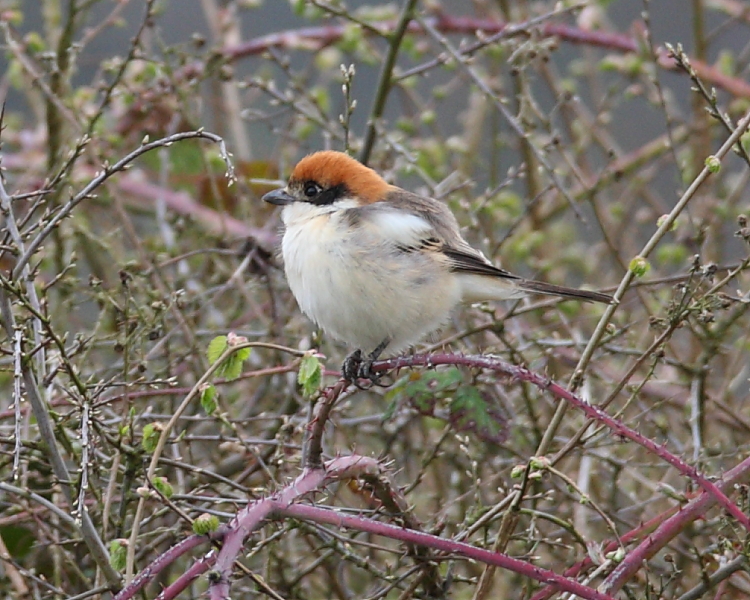
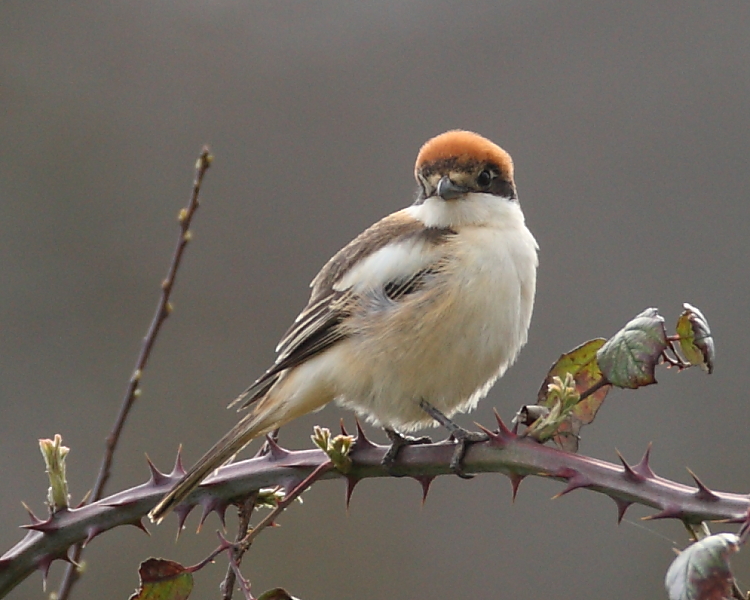
Monday 22nd April [A grey day]
There were 2 Common Sandpipers Actitis hypoleucos present today, with one on the dam and one at Holt Bay, but I don't have much else to report other than 2 Common Goldeneyes Bucephala clangula at Top End. I had a look for some new Hoverflies, but there was only one, brief, sunny spell around the middle of the day and I could only find common Eristalis spp.
I ran my 15W Heath Trap overnight (min. temp. 5 Celsius) at Lodge Copse and caught:
- B&F1750 Water Carpet Lampropteryx suffumata 1
- B&F2187 Common Quaker Orthosia cerasi 2
Tuesday 23rd April [Sunny with a steady breeze] ST. GEORGE'S DAY
A Common Sandpiper Actitis hypoleucos was on the dam this morning (2 this evening) and a pair of Common Shelducks Tadorna tadorna feeding over at Paradise (between Peg's Point and Ash Tree) until disturbed by a boat. I met Terry Grant and his wife who'd seen a Eurasian Hobby Falco subbuteo, a Peregrine Falco peregrinus, 3 Garden Warblers Sylvia borin and at least 20 Common Swifts Apus apus.
I went to look for Hoverflies and check out various parts of the site in readiness for a visit by Somerset Invertebrates Group tomorrow, during which I found some Oil Beetle Meloe sp. larvae (known as triungula) sitting in Lesser Celandine Ranunculus ficaria flowers. I saw an adult Violet Oil Beetle Meloe violaceus a few days ago but didn't disturb it, so it was especially exciting to see these tiny larvae waiting to hitch a ride on a solitary bee back to its nest (where the beetle larvae eat the bees provisions and very often the bee larvae too). They are increasingly rare and are UK BAP species, included in the Natural Environment and Rural Communities Act 2006 - Species of Principal Importance in England (NERC Act, 2006 s.41). There were quite a few Dark-edged Bee-flies Bombylius major on the wing in the sunshine today as well. They are another insect that look for solitary bee nests to lay their eggs in.
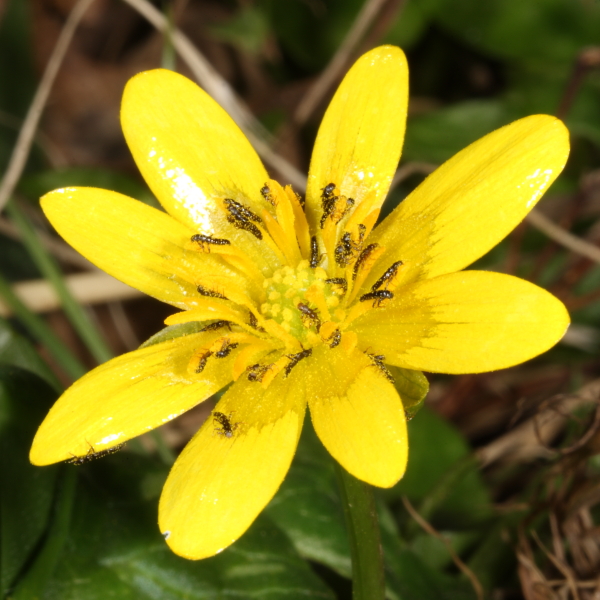
I caught 3 Hoverflies as follows:
- Platycheirus albimanus ♂♀
- Cheilosia pagana [first site record] ♀
This evening the wind dropped and there were untold millions of Chironomid midges on the wing around the lake. I went to the North Shore and was amazed at the sight of thousands roosting on the back of Rugmoor Gate. Note that they all have plumose antennae and are, therefore, males apparently all of the same species.
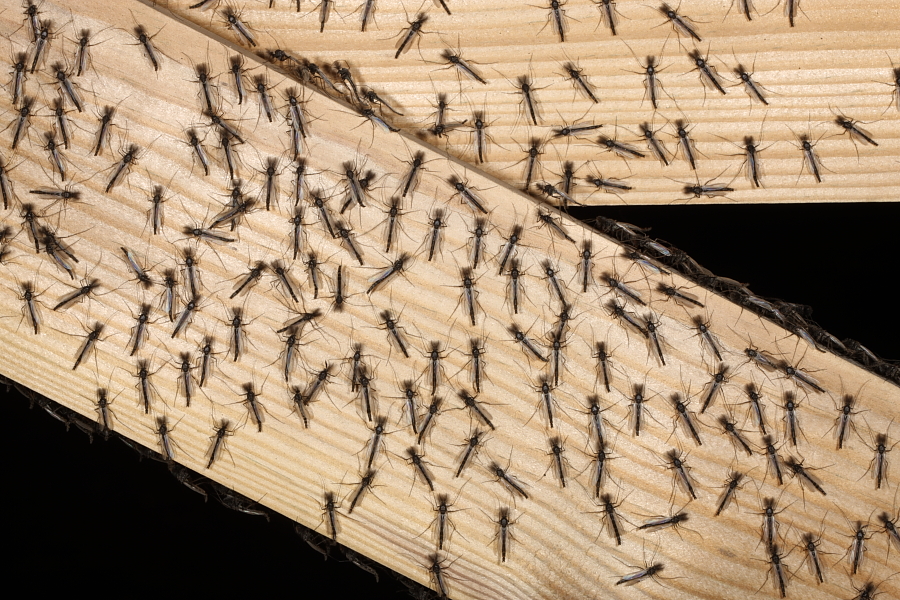
I ran my 15W Heath Trap overnight (min. temp. 6 Celsius) at Holt Copse and caught:
- B&F2187 Common Quaker Orthosia cerasi 2
- B&F2188 Clouded Drab Orthosia incerta 1
- B&F2469 HeraldScoliopteryx libatrix 1
Wednesday 24th April [Overcast all day]
Somerset Invertebrates Group visited today and our highlight was finding 5 adult Violet Oil Beetles Meloe violaceus and at least 30 Lesser Celandine Ranunculus ficaria flowers with triungula in them spread across ST5159 and ST5258. Bill and I also deployed some traps for aquatic invertebrates a couple of days ago and he has some aquatic beetles to be determined as a result, one of which was the Wasp Diving Beetle Dytiscus circumflexus, the species he'd really hoped to catch. I found the Beetle Oedemera (Oncomera) femoralis (Notable-B). Sadly the sun didn't come out at all, especially after yesterdays show, and we struggled to find many flying Bees Hymenoptera and Hoverflies Syrphidae. Toddy found a few a Spiders Araneae that I hope will add to the rather meagre site list, though it is rather early in the season to be recording them in numbers.
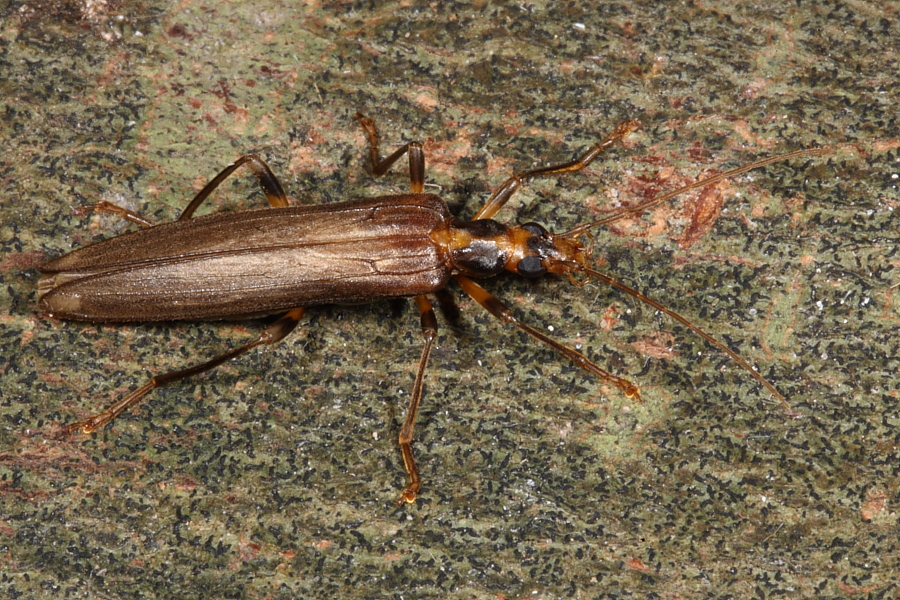
On the bird front there wasn't too much to excite today. I saw a single Common Sandpiper Actitis hypoleucos, 2 Common Goldeneyes Bucephala clangula and heard my first Lesser Whitethroat Sylvia curruca of the year at the Lodge. The pair of Common Shelducks Tadorna tadorna flew out west over the dam last night but I saw a pair fly back in to the lake again this morning.
Thursday 25th April [Overcast again]
Top bird this morning was another ♂ Wood Warbler Phylloscopus sibilatrix singing in one of the areas off the beaten track. There was also a 'possible' heard briefly at Top End, until a Eurasian Hobby Falco subbuteo and Eurasian Sparrowhawk Accipiter nisus circled overhead, but I couldn't confirm it by sight, so will have to let that one go for now (I had another listen for it this evening without success). There seems to have been a small 'fall' of Sedge Warblers Acrocephalus schoenobaenus, with 3 singing within a few metres of one another at Top End, and I saw the pair of Common Shelducks Tadorna tadorna again, ♂ Common Goldeneye Bucephala clangula at Burmah Road and 4 Common Sandpipers Actitis hypoleucos on North Shore. Later on there were 1000+ Barn Swallows Hirundo rustica over the lake.
The first orchid was coming into flower today (it will be out by tomorrow), almost a month later than last year when Richard Mielcarek and I both noted them on 29th March. I suspect it's a Green-winged Anacamptis morio, though Early Purple Orchis mascula wouldn't be out of the question.
The Nathusius's Pipistrelle Bat Survey planned for tomorrow evening, has been postponed until Sunday. I'll post details when finalised.
Friday 26th April [Sunny with a cool wind]
There were 3 Common Sandpipers Actitis hypoleucos on the dam first thing this morning, but no sign of the Wood Warbler. I then walked from Bull's Cross, Slad to Sapperton with friends where I saw my first Green-veined White and hoverfly Portevinia maculata of the year.
Mervyn Pearce emailed to tell me he'd seen 3 Eurasian Hobbies Falco subbuteo, 2 Common Buzzards Buteo buteo, a ♀ Eurasian Sparrowhawk Accipiter nisus, a Great Spotted Woodpecker Dendrocopos major, a Coal Tit Periparus ater, 5 Goldcrests Regulus regulus, 4 Chiffchaffs Phylloscopus collybita, 3 Eurasian Treecreepers Certhia familiaris, 15 Blackcaps Sylvia atricapilla (of which 14 were ♂♂), a Garden Warbler Sylvia borin heard and seen, 2 Sedge Warblers Acrocephalus schoenobaenus, 2 Willow Warblers Phylloscopus trochilus, at least 300+ Barn Swallows Hirundo rustica, 300+ Common Swifts Apus apus and only 4 House Martins Delichon urbicum.
Saturday 27th April [Sunny intervals with a cool NE wind]
Bill Urwin kindly sent the following link about Oil Beetles Meloe sp. and their larvae which helps with identification of the triungula: http://johnwalters.co.uk/research/oil-beetle-triungulin-larvae.php. It would be worth looking out for M. violaceus triungulae on Lesser Celandine Ranunculus ficaria flowers over the coming week or two if you've got a local patch with lots of flowers. I found some more triungulae at Blagdon Lake today. The adults are not easily identified but the Buglife guide is helpful see: http://www.buglife.org.uk/Resources/Buglife/Buglife%20oil%20beetle%20ID%20guide%20web%20lrg.pdf
I took a stroll at Top End this lunchtime and saw 2 Eurasian Hobbies Falco subbuteo, the ♀ Common Goldeneye Bucephala clangula, a new Common Whitethroat Sylvia communis and 4 Common Linnets Carduelis cannabina. 3 Common Sandpipers Actitis hypoleucos were at Cheddar Water, and I saw 2 later at Green Lawn, but assume these to be the same ones.
Daniel has decided that we won't be doing the Nathusius's Survey tomorrow night due to the threat of rain and the underweight condition of bats in general, thanks to the poor summer of 2012 and protracted wintery weather.
Sunday 28th April [Cool and overcast]
Not too much to report because the place was crawling with anglers (a boat competition). I saw the ♀ Common Goldeneye Bucephala clangula at Top End this evening, and I'm beginning to suspect it's the bird that sticks around for the summer at Chew and Blagdon. There were 3 Common Sandpipers Actitis hypoleucos on the dam and I saw a single Hobby Falco subbuteo over the Indian Country pine belt during my visits. Oh, and there was a brief heart-stopping moment when I spotted a small hooded gull way out off the dam, but instead of it being the Chew Bonaparte's Gull, it turned out to be a 1st-year Black-headed Gull Chroicocephalus ridibundus. Rats!
The passive bat monitoring equipment has been running in Ubley Hatchery grounds for the last 3 weeks and recorded 6500 files. See Bat Info News.
Monday 29th April [Sunny with a stiff WNW breeze]
I spent about 5 hours surveying beside the lake today, but there isn't much to tell about the birds. There were 3 Eurasian Hobbies Falco subbuteo over Top End, where I also saw the ♀ Common Goldeneye Bucephala clangula, and I counted 3♂♂ Common Whitethroats Sylvia communis singing along the south side hedges and a single ♂ Lesser Whitethroat singing along the north side. So, we have a full complement of regular summer warblers, and await the arrival of Spotted Flycatchers.
I found the following hoverflies today:
- Melanostoma scalare ♂
- Platycheirus albimanus ♂♀
- Syrphus ribesii ♂
- Rhingia campestris
- Eristalis arbustorum ♂
- Eristalis pertinax
Green-winged Anacamptis morio and Early Purple Orchids Orchis mascula are coming into flower in small numbers at long last, as is Cow Parsley Anthriscus sylvestris which has been shooting up, and I was amazed at the number of Alder Flies Sialis sp. emerging around Butcombe Bay.
Tuesday 30th April [Sunny]
I didn't visit until late morning, intending to spend time looking for invertebrates, but when I got to Top End hide I caught a glimpse of an adult ♀ Marsh Harrier Circus aeruginosus. I saw it again a few more times between 1300-1400 hrs, when I got a few record shots with my f2.8 100 mm macro lens, before one of the Top End Common Buzzard Buteo buteo pair saw it off. I didn't see where it went. This is, perhaps surprisingly, only the 10th site record. The ♀ Common Goldeneye Bucephala clangula is still present.
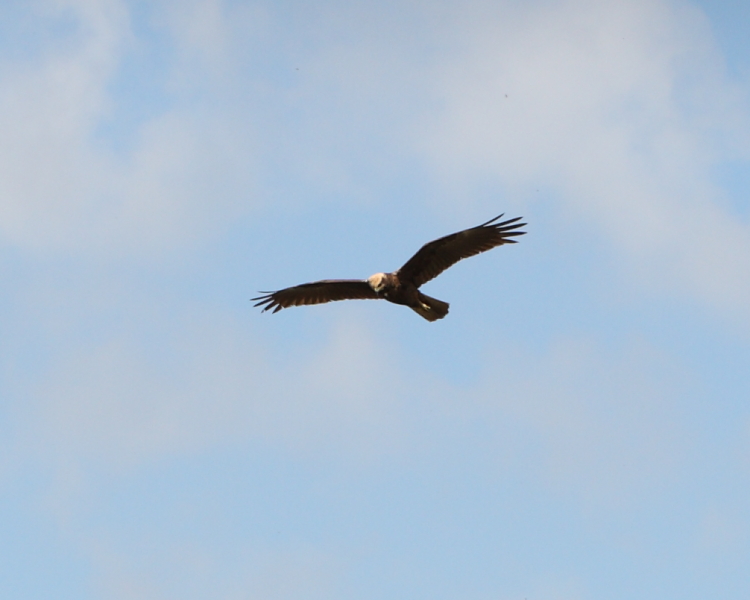
I found an Orange Ladybird Halyzia sedecimguttata, which I don't have on the beetle list, but which I'm sure I've seen at the lake before. I also saw a Brimstone Gonepteryx rhamni butterfly, but there's still no sign of an Orange-tip Anthocharis cardamines yet. Hoverflies caught today included:
- Syrphus vitripennis [first site record] ♂
- Cheilosia pagana ♂
- Helophilus pendulus ♂
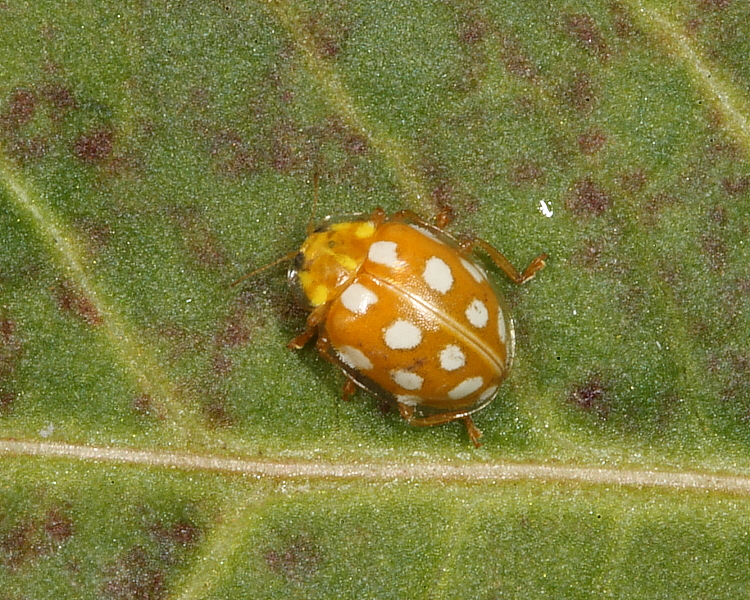
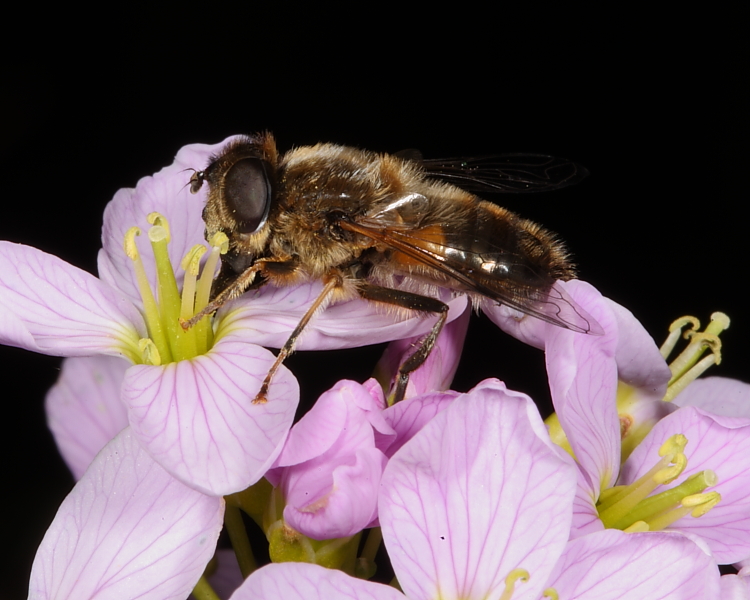
This morning, Simon Mackie sent me some nice pictures of a ♂ Violet Oil Beetle Meloe violaceus taken at Hollow Brook, Chew Valley Lake on Sunday 28th April by his sister-in-law Sue. This picture illustrates the size (about 30mm long) with the inclusion of a finger. Look out for them and report findings to Bristol Environmental Records Centre who will, I'm sure, be glad of records. If you see what you think might be one and want me to take a look at your photos, feel free to send them. Rough, unimproved pastures and woodland edges / banks are the places to look - especially if there is an abundance of Lesser Celandine in flower.
